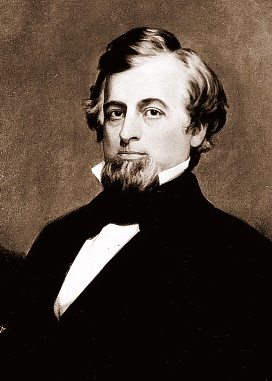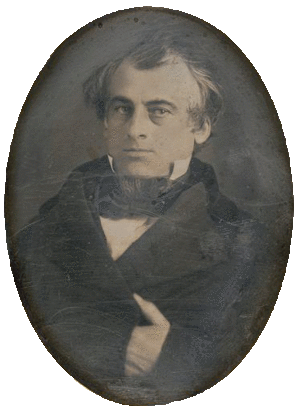William A. Barstow facts for kids
William Augustus Barstow (September 13, 1813 – December 13, 1865) was an American businessman and politician. He served as the third Governor of Wisconsin and also as the second Secretary of State for Wisconsin. During the American Civil War, he was an officer in the Union Army. Before Wisconsin became a state, he played a big part in creating Waukesha County.
Quick facts for kids
William A. Barstow
|
|
|---|---|

1850s portrait of Barstow by William F. Cogswell
|
|
| 3rd Governor of Wisconsin | |
| In office January 2, 1854 – March 21, 1856 |
|
| Lieutenant | James T. Lewis Arthur MacArthur, Sr. |
| Preceded by | Leonard J. Farwell |
| Succeeded by | Arthur MacArthur, Sr. (acting) Coles Bashford (elected) |
| 2nd Secretary of State of Wisconsin | |
| In office January 7, 1850 – January 5, 1852 |
|
| Governor | Nelson Dewey |
| Preceded by | Thomas McHugh |
| Succeeded by | Charles D. Robinson |
| Personal details | |
| Born |
William Augustus Barstow
September 13, 1813 Plainfield, Connecticut, U.S. |
| Died | December 13, 1865 (aged 52) Leavenworth, Kansas, U.S. |
| Cause of death | Chronic diarrhea |
| Resting place | Brookmere Cemetery Cleveland, Ohio |
| Spouse |
|
| Children |
|
| Parents |
|
| Relatives | John L. Barstow (1st cousin, once removed) |
| Military service | |
| Allegiance | |
| Branch/service | Union Army |
| Years of service | 1861–1865 |
| Rank | |
| Commands | 3rd Reg. Wis. Vol. Cavalry |
| Battles/wars | American Civil War |
Contents
Early Life and Moving West
William Barstow was born in Plainfield, Connecticut, in 1813. He grew up on his family's farm and went to local schools. When he was 16, he moved to Norwich, Connecticut. There, he worked as a clerk in a store owned by his brother, Samuel.
Later, the brothers moved their business to Cleveland, Ohio. After a big economic downturn in 1837, the Barstows moved again. They settled in what was then called "Prairie Village" in the Wisconsin Territory in 1839. This area is now known as Waukesha.
Building Wisconsin Territory
The Barstow brothers built a flour mill and became important business owners in their new home. William became the local postmaster in 1842. A postmaster is in charge of a local post office. His brother, Samuel, was elected to the Territorial Legislature in 1845.
In 1843, William ran to be the sheriff of Milwaukee County. He was a candidate for the Democratic Party but lost the election.
Creating Waukesha County
During this time, people in Prairieville (Waukesha) wanted their own county. They were part of Milwaukee County, but they felt their tax money was mostly used to help Milwaukee grow. They wanted to use their taxes for improvements in their own area.
The Barstow brothers became leaders in this movement. Samuel, who was in the Legislature, helped create a bill. This bill allowed people in the proposed new county to vote on whether to separate from Milwaukee County. The vote was very close, but it passed. In 1847, Prairieville was renamed "Waukesha" and became the main town of the new Waukesha County.
Political Career in Wisconsin
Secretary of State
In 1849, William Barstow was chosen by the Democratic Party to run for Secretary of State of Wisconsin. He won the election and became Wisconsin's second Secretary of State.
During his time as Secretary of State, there were some concerns about how government money was being handled. He was not re-elected for this position in 1851.
Becoming Governor
Despite past issues, Barstow's reputation improved. In 1852, he represented Wisconsin at a big Democratic meeting in Baltimore. In 1853, he became a strong opponent of a law that would ban alcohol, known as the "Maine Liquor Law." He spoke against it across the state.
Later that year, he was nominated by the Democratic Party to run for Governor. He won the election in November 1853, becoming Wisconsin's third Governor. He took office on January 2, 1854.
As Governor, Barstow supported building a railroad across the country. He also stood against groups like the "Know-Nothing movement." These groups wanted to make it harder for people born in other countries to become citizens. As he promised, he vetoed the alcohol ban law, even though many people had voted for it.
However, more questions about money and government spending came up during his time as Governor. This caused him to lose support from people in his own party and across Wisconsin.
The Disputed Election
When Barstow ran for re-election in 1855, he was first announced as the winner by a very small number of votes. However, his opponent, Coles Bashford, claimed the election was unfair. It was found that some votes for Barstow came from places that didn't really exist.
This caused a lot of tension in the state. Two different groups claimed to be the rightful governor. Barstow was sworn in publicly on January 7, 1856. On the same day, Bashford was also sworn in quietly by the Chief Justice of the Wisconsin Supreme Court.
The state's Attorney General took the case to the Wisconsin Supreme Court. Barstow eventually gave up his office on March 21, 1856. The court then officially declared Coles Bashford as the rightful governor.
Later Life and Civil War Service
After leaving office, Barstow moved to Janesville, Wisconsin. He started a bank and worked on plans to build railroads. His bank later failed during another economic downturn in 1857.
When the American Civil War began, Barstow offered to create a cavalry regiment (a group of soldiers on horseback). He successfully formed the 3rd Wisconsin Cavalry Regiment. This group joined the Union Army on January 31, 1862.
Colonel Barstow and his regiment were sent to Kansas. He became the Provost Marshal of Kansas, which meant he was in charge of military police duties. He was based at Fort Leavenworth. After several months, Colonel Barstow became ill. In 1863, he was reassigned to oversee military court cases in St. Louis, Missouri.
He left the army on March 4, 1865. He was later given a special promotion to Brigadier General.
William Barstow stayed in Leavenworth, Kansas, after the war. His health continued to get worse due to a long-term illness. He passed away in Leavenworth, Kansas, on December 13, 1865.
Family and Legacy
William A. Barstow was married to Maria Quarles. They had four sons.
His uncles, John and Ebenezer Barstow, fought as volunteers in the American Revolutionary War. A relative, John L. Barstow, later became the 39th Governor of Vermont.
Barstow Street in downtown Waukesha, Wisconsin, is named after him.
Images for kids



